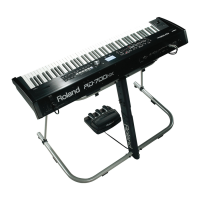74
Detailed Settings for Each Function
Reverb/Chorus Settings
Here you can edit the reverb and chorus settings.
NOTE
Making abrupt changes in the settings values may cause the sound
to become distorted or overly loud. Carefully monitor volume levels
while making the settings.
1. Press the [MENU] button, getting the indicator to light.
The Menu screen appears.
2. Press the Cursor [ ] [ ] buttons to select “3.Eects.”
3. Press the [ENTER] button to display the Edit screen.
“Reverb” Settings Screen
“Chorus” Settings Screen
4. Press the Cursor [ ] [ ] buttons to switch screens, and
press the Cursor [ ] [ ] buttons to move the cursor to the
parameter to be set.
5. Use the [DEC] [INC] buttons or the VALUE dial to set the
value.
6. When you have nished making the settings, press the
[MENU] button, extinguishing its indicator.
You’ll be returned to the Live Set screen or the One Touch screen.
Making Reverb Settings
Reverb adds the reverberation characteristics of halls or auditoriums.
Six dierent types are oered, so you can select and use the type that
suits your purpose.
You can set the amount of reverb applied separately for each
individual tone (p. 56).
Reverb Type
Select the reverb type.
When you change the Reverb Type, the Reverb parameters will be
automatically adjusted to the optimal values. Rather than setting the
reverb parameters one by one, you can make the settings more easily
by rst setting the Reverb Type and then changing only the necessary
parameters.
The way the [REVERB] button’s indicators light changes with the
selected type.
Parameter Value Description
Rev Type
(Reverb Type)
OFF
No reverb is used.
The indicator does not light.
REVERB
Normal Reverb.
The “HALL” indicator ashes.
ROOM
Simulates the reverberation
of room interiors. It produces
a welldened and spacious
reverberation.
The “ROOM” indicator remains lit.
HALL
Simulates the reverberation
exhibited by hall. It provides a
deeper reverberation than the
Room reverbs.
The “HALL” indicator remains lit.
PLATE
Simulates a plate reverb unit
(a type of articial reverb that
utilized a metal plate).
The “ROOM” indicator ashes.
GM2 REVERB
This is a GM2 reverb.
The “CATHEDRAL” indicator
ashes.
CATHEDRAL
This reproduces the reverb found
in a church cathedral.
The “CATHEDRAL” indicator
remains lit.
Other Reverb Settings
You can make even more detailed reverb settings.
When you select a Reverb Type, a number of parameters unique to that
type are displayed.

